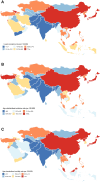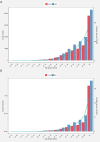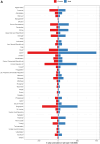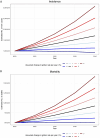Epidemiology and socioeconomic correlates of colorectal cancer in Asia in 2020 and its projection to 2040
- PMID: 40695969
- PMCID: PMC12284187
- DOI: 10.1038/s41598-025-12545-y
Epidemiology and socioeconomic correlates of colorectal cancer in Asia in 2020 and its projection to 2040
Abstract
Asia bears a disproportionate and rapidly rising burden of colorectal cancer (CRC). However, the incidence and mortality trends vary significantly between Asian countries, mainly due to the diversity of socioeconomic factors and the implementation of screening programs. This study aimed to report the contemporary distribution, socioeconomic correlates, and projections for future trends of CRC across Asia. The Global Cancer Observatory (GLOBOCAN) for the year 2020 was used to obtain data on prevalence, incidence, and mortality rates of CRC. We calculated mortality-to-incidence ratios (MIRs), age-standardized incidence and mortality rates (ASIR and ASMR), crude rates, numbers, and 5-year prevalent cases and rates by age, sex, and subregions of Asia. We assessed the correlation between indicators and human development index (HDI) and the ratio of current health expenditure (CHE) to gross domestic product (GDP) using Pearson's correlation coefficient. Estimated incidence or mortality rates between 2025 and 2040 were calculated by multiplying age-specific rates for 2020 by the estimated population between 2025 and 2040. In Asia, the 5-year prevalence rate, ASIR, and ASMR of CRC were 55.60, 17.30, and 8.40 per 100,000, respectively. The highest crude incidence and mortality rates were in the 70 + age group. Males had higher ASIRs than females (20.80 vs. 14.00 per 100,000) in Asia. MIRs for men and women were 0.49 globally and 0.50 and 0.51 in Asia, respectively. A positive significant correlation was observed between HDI and both the ASIR and ASMR. A strong negative correlation was observed between HDI and MIR. The number of incident and mortality cases are estimated to increase by 71.10% and 85.10% in 2040, respectively. CRC is a significant public health concern in Asia, with substantially high incidence and mortality rates in East Asia and lower quality of care and survival in less developed regions of the continent. Resource allocation prioritizing population-based screenings alongside capacity building around specialized care centers is crucial across the Asian countries.
Keywords: Colon cancer; Colorectal neoplasm; Epidemiology; GLOBOCAN; Incidence; Mortality; Prevalence.
© 2025. The Author(s).
Conflict of interest statement
Declarations. Competing interests: The authors declare no competing interests. Ethics approval and consent to participate: Given the nature of this study and the data which is publicly available, there was no requirement for institutional review board submission and do not require patient informed consent. All data from GLOBOCAN database were fully anonymized.
Figures







Similar articles
-
Cancer incidence and mortality estimates in 2022 in southeast Asia: a comparative analysis.Lancet Oncol. 2025 Apr;26(4):516-528. doi: 10.1016/S1470-2045(25)00017-8. Epub 2025 Feb 27. Lancet Oncol. 2025. PMID: 40024257
-
Global burden of female breast cancer: new estimates in 2022, temporal trend and future projections up to 2050 based on the latest release from GLOBOCAN.J Natl Cancer Cent. 2025 Feb 13;5(3):287-296. doi: 10.1016/j.jncc.2025.02.002. eCollection 2025 Jun. J Natl Cancer Cent. 2025. PMID: 40693239 Free PMC article.
-
Cancer Burden in Chinese Older Adults: Insights Into Incidence, Mortality, and Global Comparisons Using GLOBOCAN 2022.Aging Med (Milton). 2025 Jun 29;8(3):229-237. doi: 10.1002/agm2.70028. eCollection 2025 Jun. Aging Med (Milton). 2025. PMID: 40620515 Free PMC article.
-
National and subnational burden of brain and central nervous system cancers in China and global from 1990 to 2021: results from the global burden of disease study 2021.Arch Public Health. 2025 Jul 28;83(1):195. doi: 10.1186/s13690-025-01683-4. Arch Public Health. 2025. PMID: 40722045 Free PMC article.
-
[Volume and health outcomes: evidence from systematic reviews and from evaluation of Italian hospital data].Epidemiol Prev. 2013 Mar-Jun;37(2-3 Suppl 2):1-100. Epidemiol Prev. 2013. PMID: 23851286 Italian.
References
-
- Sung, H. et al. Global cancer statistics 2020: GLOBOCAN estimates of incidence and mortality worldwide for 36 cancers in 185 countries. CA Cancer J. Clin.71(3), 209–49 (2021). - PubMed
-
- Bray, F. et al. Global cancer statistics 2022: GLOBOCAN estimates of incidence and mortality worldwide for 36 cancers in 185 countries. CA Cancer J. Clin.74(3), 229–63 (2024). - PubMed
-
- Morgan, E. et al. Global burden of colorectal cancer in 2020 and 2040: Incidence and mortality estimates from GLOBOCAN. Gut72(2), 338–344 (2023). - PubMed
-
- Onyoh, E. F. et al. The rise of colorectal cancer in Asia: Epidemiology, screening, and management. Curr. Gastroenterol. Rep.21, 1–10 (2019). - PubMed
-
- Rajappa, S., Singh, M., Uehara, R., Schachterle, S. E. & Setia, S. Cancer incidence and mortality trends in Asia based on regions and human development index levels: An analyses from GLOBOCAN 2020. Curr. Med. Res. Opin.39(8), 1127–1137 (2023). - PubMed
MeSH terms
LinkOut - more resources
Full Text Sources
Medical

